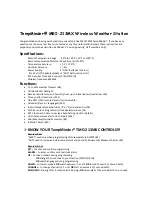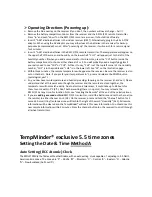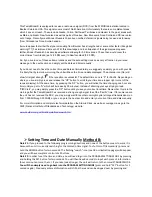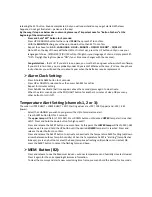
Miscellaneous
Information/Hints:
Locate
the
Transmitter
out
of
direct
sunlight.
Even
though
the
unit
is
“weather
proof”
try
to
keep
it
out
of
direct
rain
or
snow
as
much
as
possible.
Under
an
eave,
window
sill
or
overhang
is
ideal.
If
temperatures
in
your
area
drop
below
‐
20°C/
‐
4°F
use
Lithium
batteries
in
the
transmitter.
IF:
you
lose
the
signal
from
the
remote
transmitter.
Press
and
hold
the
CHANNEL
button
for
2
seconds.
This
will
initiate
a
3
minute
search.
If
still
not
found,
read
below.
If
your
TempMinder
has
been
functioning
for
6
months
or
longer,
you
will
likely
resolve
the
problem
by
replacing
the
batteries
in
both
the
transmitter(s)
and
the
receiver.
If
the
problem
persists,
the
cause
is
probably
electronic
interference
from
another
device.
This
is
very
difficult
to
determine
and
all
we
can
suggest
is
moving
the
receiver
and
transmitter
to
various
locations.
Quite
often
a
move
of
even
a
few
feet
(meters)
in
one
direction
or
another
will
resolve
the
issue.
It
is
interesting
to
note
that
RF
(Radio
Frequency
signals)
will
transmit
better
through
a
concrete
wall
than
glass!
Weather
Forecast:
This
function
mainly
considers
the
change
in
atmospheric
pressure
and
is
fairly
accurate
within
a
10
mile
(16
km)
radius.
This
accuracy
will
be
greatly
reduced
if
the
TempMinder®
is
constantly
located
in
an
enclosed
environment
(air
conditioned
or
heated
well
sealed
home).
This
can
be
modified
somewhat
by
temporarily
placing
the
receiver
near
an
open
window,
in
the
garage
or
even
outside
on
a
protected
porch
or
balcony.
Understand
that
this
forecast
is
not
meant
to
replace
the
Weather
Channel
or
your
local
weather
man!!!
FCC Statement:
This equipment has been tested and found to comply with the limits for Part 15 of the FCC rules. These limits are designed to provide
reasonable protection against harmful interference in a residential installation.
This equipment generates, uses and can radiate radio frequency energy and, if not installed and used in accordance with the
instructions, may cause harmful interference to radio communications.
However, there is no guarantee that interference will not occur in a particular installation. If this equipment does
cause harmful interference to radio or television reception, which can be determined by turning the equipment
off and on, the user is encouraged to try to correct the interference by one or more of the following measures:
•
Reorient or relocate the receiving antenna.
•
Increase the separation between the equipment and receiver.
•
Connect the equipment to an outlet on a circuit different from that to which the receiver is connected.
This device complies with part 15 of the FCC rules. Operation is subject to the following two conditions: (1) This device may not
cause harmful interference, and (2) this device must accept any interference received, including interference that may cause
undesired operation.
Note: Modifications to this product will void the user
’
s authority to operate this equipment.

























